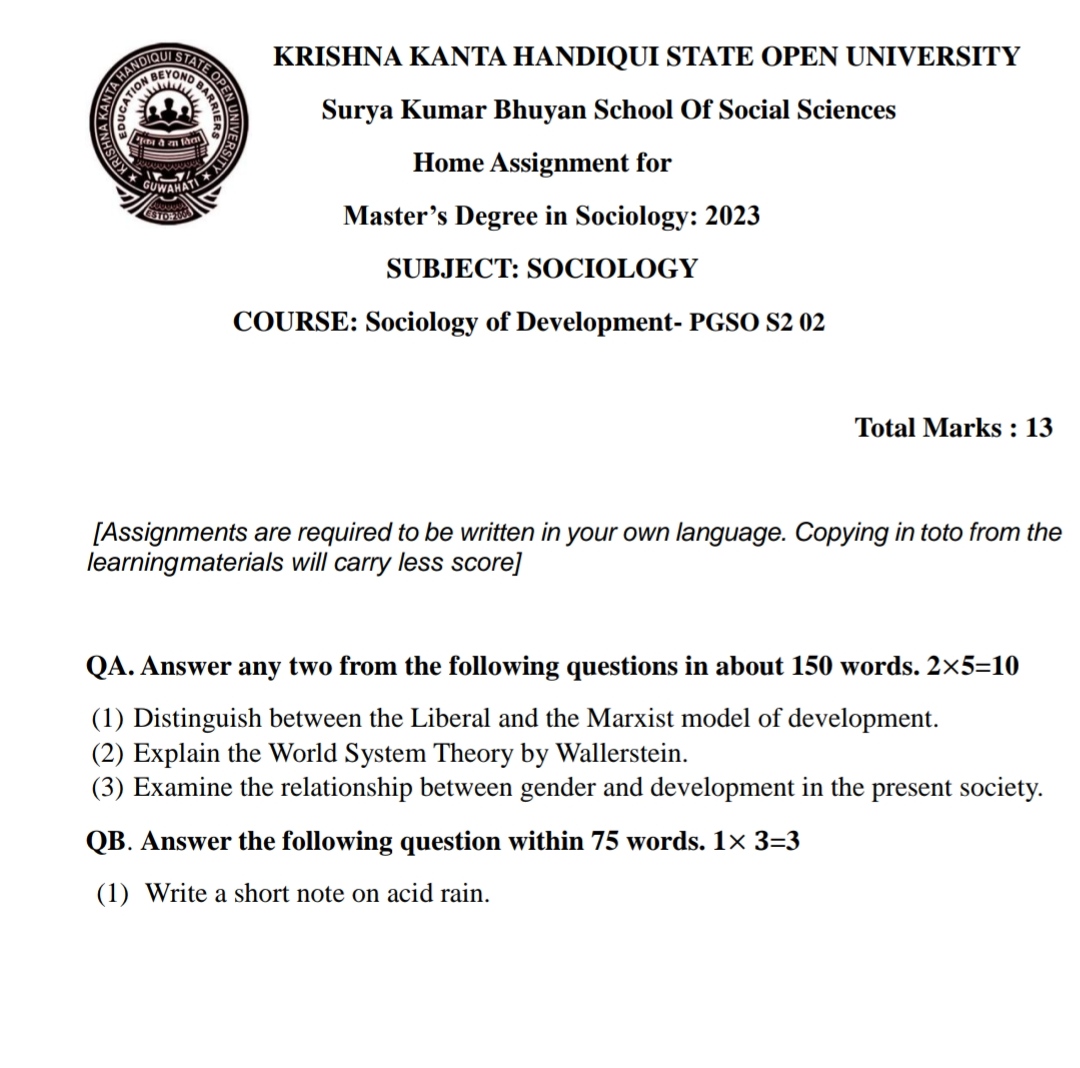QA. Answer any two from the following questions in about 150 words. 2 5=10
(1) Distinguish between the Liberal and the Marxist model of development.
Ans:- The Liberal and Marxist models of development represent divergent ideologies and approaches to socioeconomic progress. The Liberal model emphasizes individual freedom, private property rights, and a free-market economy with minimal state intervention. It aims for economic growth and efficiency as the driving forces behind development, believing that individual prosperity will ultimately benefit society as a whole.
In contrast, the Marxist model prioritizes social equality and collective ownership of the means of production. It advocates for a more significant role of the state in the economy to eliminate exploitation and class struggle. According to Marxism, capitalism inherently fosters inequality, and true development can only be achieved through the abolition of private ownership and the establishment of a classless society.
While the Liberal model seeks to achieve development through market mechanisms and individual incentives, the Marxist model envisions progress through communal ownership and an active state guiding socioeconomic affairs. In practice, many countries adopt mixed approaches, combining elements of both models to address various development challenges.
(2) Explain the World System Theory by Wallerstein.
Ans:- The World System Theory, developed by sociologist Immanuel Wallerstein, is a macro-level analysis of global economic and social structures. It offers a comprehensive framework to understand the historical development and ongoing dynamics of the global capitalist system. According to Wallerstein, the world system is a complex network of economic and political relationships that link countries together in a hierarchical manner.
The theory posits that the world system is characterized by a core-periphery structure. The core consists of dominant, industrialized nations that control and benefit the most from global economic activities. These core countries exploit peripheral regions, which are typically less developed and serve as sources of cheap labor and raw materials.
Wallerstein identifies three main types of zones within the world system:
- Core: Advanced industrialized nations with significant economic and political power.
- Periphery: Less developed countries that provide labor and resources to the core.
- Semi-periphery: Countries that possess some industrialization but are still subordinate to the core economies.
The World System Theory highlights how these zones’ relationships are shaped by capitalist expansion and exploitation, leading to cycles of economic development and underdevelopment. The theory encourages a critical examination of global inequalities and emphasizes the interdependence between countries within the world system.
(3) Examine the relationship between gender and development in the present society.
Ans : In the present society, the relationship between gender and development remains a significant and complex issue. While progress has been made in some areas, gender disparities persist in various aspects of development. Gender refers to the social, cultural, and economic roles and expectations attributed to individuals based on their perceived sex, often leading to unequal treatment and opportunities.
In many societies, women and girls continue to face barriers that hinder their full participation in development processes. These barriers include limited access to education, healthcare, economic opportunities, and political representation. Gender-based violence and discriminatory cultural norms further exacerbate inequalities.
Recognizing the importance of addressing these challenges, efforts have been made to integrate gender perspectives into development policies and programs. Gender mainstreaming aims to ensure that the specific needs and experiences of women and men are considered in all development initiatives.
Promoting gender equality is not only a matter of social justice but also essential for sustainable and inclusive development. Empowering women economically, socially, and politically can lead to increased productivity, improved health and education outcomes, and reduced poverty rates.
Despite progress, the road to gender equality and development remains uneven. It requires continuous efforts from governments, civil society, and international organizations to challenge discriminatory norms, create inclusive opportunities, and ensure that development benefits all members of society regardless of their gender.
QB. Answer the following question within 75 words. 1×3 =3
Ans:- Acid rain is a type of precipitation that is more acidic than normal rain. It is caused by the release of sulfur dioxide and nitrogen oxides into the atmosphere, which react with water vapor to form acids. Acid rain can have harmful effects on the environment, including damage to forests, lakes, and buildings.
Here are some of the key points about acid rain:
- It is caused by the release of sulfur dioxide and nitrogen oxides into the atmosphere.
- It can be in the form of rain, snow, fog, or sleet.
- It can have harmful effects on the environment, including damage to forests, lakes, and buildings.
- There are a number of things that can be done to reduce acid rain, such as using cleaner fuels and installing pollution controls on power plants.
